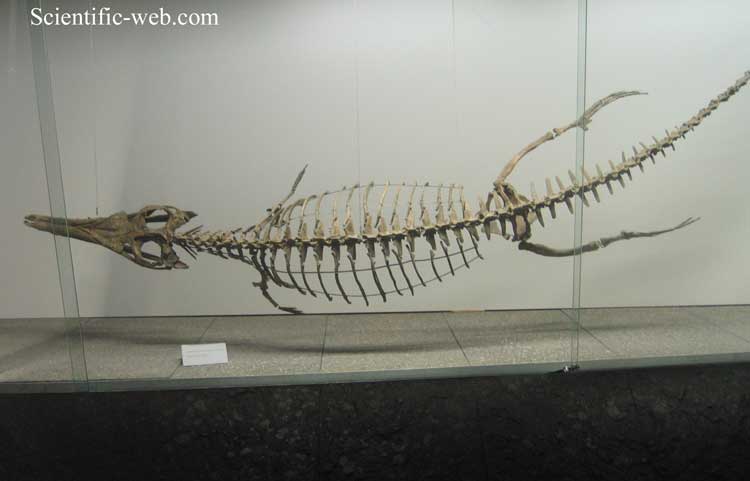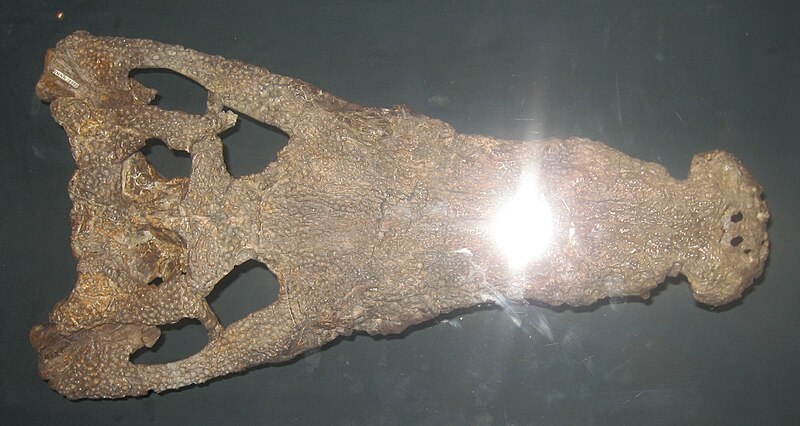[Recent Entries][Archive][Friends][User Info]
May 3rd, 2012
| May 3rd, 2012 | |
|---|---|
| 06:51 pm [industrialterro] [Link] |
Metriorhynchus Metriorhynchus is an extinct genus of marine crocodyliform that lived in the oceans during the Middle to Late Jurassic. Metriorhynchus was named by the German palaeontologist Christian von Meyer in 1830. Metriorhynchus was a carnivore that spent much, if not all, its life out at sea. No Metriorhynchus eggs or nests have been discovered, so little is known of the reptile's lifecycle, unlike other large marine reptiles of the Mesozoic, such as plesiosaurs or ichthyosaurs which are known to give birth to live young out at sea. Where Metriorhynchus mated, whether on land or at sea, is currently unknown. The name Metriorhynchus means "Moderate snout", and is derived from the Greek Metrio- ("moderate") and -rhynchos ("snout"). Fossil specimens referrable to Metriorhynchus are known from Middle-Late Jurassic deposits of England, France and Germany. Species in this genus are traditionally classed into two skull groups: longirostrine (long, narrow jaws) and brevirostrine (short, broad jaws). However there has been some contention as to how many of these species are valid, especially those from the Callovian. All brevirostrine species have been transferred to the genera: Purranisaurus and Suchodus. Eudes-Deslongchamps (1867–69) found there to be four Callovian species: M. superciliosus, M. moreli, M. blainvillei, and M. brachyrhynchus. Andrews (1913) considered there to be seven valid species: M. superciliosus, M. moreli, M. brachyrhynchus, M. durobrivensis, M. cultridens, M. leedsi and M. laeve. Adams-Tresman (1987) using linear morphometrics however could only distinguish between the two skull groups, so she found there to be two species: M. superciliosus and M. brachyrhynchus. Vignaud (1997) however, considered there to be three Callovian species: M. superciliosus, M. brachyrhynchus and M. leedsi. M. superciliosus: Western Europe (England, France and Germany) of the Middle-Late Jurassic (Callovian and Oxfordian); M. moreli, M. blainvillei, and M. jaekeli are junior synonyms. M. hastifer: Western Europe (France) of the Late Jurassic (Kimmeridgian) M. geoffroyii: (type species) Western Europe (England, France and Switzerland) of the Late Jurassic (Kimmeridgian); M. palpebrosus, and M. temporalis are junior synonyms. Two longirsotrine species, M. acutus and M. leedsi have been referred to the genus Gracilineustes. Fragmentary remains of Metriorhynchus are known from South America during the Bajocian and Bathonian (both Middle Jurassic). However, phylogenetic analysis has shown neither of these species can be referred to Metriorhynchus. The genera Purranisaurus and Suchodus have been considered junior synonyms of Metriorhynchus, Recent phylogenetic analyses however, do not support the monophyly of Metriorhynchus. Some of the longirostrine forms, however, do appear to form a natural group. The cladogram presented below follows an analysis by Mark Young and Marco Brandalise de Andrade, published in November 2009. Averaging 3 metres (9.8 ft) in length, Metriorhynchus was of a similar size to modern crocodiles. However, it had a streamlined body and a finned tail, making it a more efficient swimmer than modern crocodilian species. Recent examination of the fossil specimens of Metriorhynchus superciliosus, have shown that adults of this species had well-developed salt glands. This means that like Geosaurus it would have been able to "drink" salt-water (necessary for a pelagic animal) and eat prey that have the same ionic concentration as the surrounding sea water (i.e. cephalopods) without dehydrating. Metriorhynchus was a versatile and opportunistic predator, predated upon both the armoured belemnites, fast moving fish and the giant filter feeding fish Leedsichthys. Occasionally it was also capable of capturing flying animals such as the pterosaurs and scavenging on plesiosaur carcasses on the seafloor. Even though Metriorhynchus was an effective predator, it was vulnerable to predation from apex predators such as Liopleurodon which could grow in excess of 10 meters in length. Since Metriorhynchus had lost its osteoderms, "Armour scutes", to become more efficient swimmers it would have had little defense against larger marine predators.
Репродукции (1, 2, 3, 4, 5, 6, 7, 8):
( Далее ) Ископаемые останки (1, 2, 3, 4, 5):
Tags: Вымершие рептилии, Юра, архозавроморфы, архозавры, диапсиды, крокодиломорфы, круротарзы, мезоэукрокодилии, метриоринхиды, равизухии, талаттозухии |
| Time | Event |
| 07:34 pm [industrialterro] [Link] |
Cricosaurus Cricosaurus is an extinct genus of marine crocodyliform belonging to the family Metriorhynchidae. The genus was established by Johann Andreas Wagner in 1858 for three skulls from the Tithonian (Late Jurassic) of Germany. The name Cricosaurus means "Ring lizard", and is derived from the Greek Cricos- ("ring") and σαῦρος -sauros ("lizard"). Fossil specimens referrable to Cricosaurus are known from Late Jurassic deposits in England, France, Switzerland, Germany, Argentina, Cuba, and Mexico. Cricosaurus was first named by Wagner in 1858, as a re-classification of a specimen he had previously described in 1852. Several other species have since been named, including C. suevicus by Fraas in 1901 (originally as a species of Geosaurus. One former species, C. medius (named by Wagner in 1858) has since been reclassified as a junior synonym of Rhacheosaurus gracilis. The original three skulls (all assigned to different species) were poorly known, and the genus had been considered a junior synonym of Metriorhynchus, Geosaurus or Dakosaurus by different palaeontologists in the past. Some phylogenetic analysis did not support the monophyly of Cricosaurus, However, a more comprehensive analysis in 2009 showed that the species contained in Cricosaurus were valid, and furthermore that several long-snouted species formerly classified in the related genera Geosaurus, Enaliosuchus and Metriorhynchus were in fact more closely related to the original specimens of Cricosaurus, and thus were re-classified into this genus. All currently known species would have been three metres or less in length. When compared to living crocodilians, Cricosaurus can be considered moderate to small-sized. Its body was streamlined for greater hydrodynamic efficiency, which along with its finned tail made it a more efficient swimmer than modern crocodilian species. Recent examination of the fossil specimens of Cricosaurus araucanensis have shown that both juveniles and adults of this species had well-developed salt glands. This means that it would have been able to "drink" salt-water from birth (necessary for a pelagic animal) and eat prey that have the same ionic concentration as the surrounding sea water (i.e. cephalopods) without dehydrating. Adult specimens of Metriorhynchus also have these well-developed salt glands. Several species of metriorhynchids are known from the Mörnsheim Formation (Solnhofen limestone, early Tithonian) of Bavaria, Germany: Dakosaurus maximus, Geosaurus giganteus, Cricosaurus suevicus and Rhacheosaurus gracilis. It has been hypothesised that niche partitioning enabled several species of crocodyliforms to co-exist. The top predators of this Formation appear to be Dakosaurus and G. giganteus, which were large, short-snouted species with serrated teeth. The long-snouted Cricosaurus species would have feed mostly on fish, although the more lightly built Rhacheosaurus may have specialised towards feeding on small prey. In addition to these four species of metriorhynchids, a moderate-sized species of Steneosaurus was also contemporaneous. From the slightly older Nusplingen Plattenkalk (late Kimmeridgian) of southern Germany, both C. suevicus and Dakosaurus maximus are contemporaneous. As with Solnhofen, C. suevicus feed upon fish, while D. maximus was the top predator.
Ископаемые останки (1, 2, 3, 4):
Tags: Вымершие рептилии, Юра, архозавроморфы, архозавры, диапсиды, крокодиломорфы, круротарзы, мезоэукрокодилии, метриоринхиды, равизухии, талаттозухии |
| Time | Event |
| 07:57 pm [industrialterro] [Link] |
Goniopholis Goniopholis is an extinct genus of crocodyliform that lived in North America, Europe and Asia during the Late Jurassic and Early Cretaceous. Being semi-aquatic it is very similar to modern crocodiles. It ranged from 2–4 metres in length, and would have had a very similar lifestyle to the American alligator or Nile crocodile. Goniopholis was closely related to the ancestor of extant crocodilians. Many species of Goniopholis have been described, G. crassidens lived during the Early Cretaceous (Berriasian) of England. Goniopholis simus is from the Early Cretaceous of NW Germany; G. gilmorei and G. stovalli are from the Late Jurassic of North America, while G. baryglyphaeus is known from the Late Jurassic (Kimmeridgian) of Portugal making it the oldest known Goniopholis species. Other Late Jurassic species such as, G. phuwiangensis is known from NE Thailand, and G. lucasii from the Tithonian of Colorado (although may belong to a different genus, Amphicotylus). Nannosuchus gracilidens from the Early Cretaceous of England is a juvenile Goniopholis. The species G. kiplingi is named for the author Rudyard Kipling, "in recognition for his enthusiasm for natural sciences. На знаменитом Юрском побережье Британии палеонтологи нашли прекрасно сохранившийся череп ископаемого крокодила. Назвать древнюю рептилию решили в честь писателя Редьярда Киплинга. Окаменевший череп размером около метра принадлежал крокодилу Goniopholis kiplingi, имевшему общую длину порядка 3,5 метра. По мнению палеонтологов Бристольского университета, гониофолис киплинги может считаться предком современных морских крокодилов. Рептилия питалась рыбами, черепахами и другими обитателями теплых тропических болот и лагун, располагавшихся на месте современного британского графства Дорсет 130 миллионов лет назад, в начале мелового периода. Как рассказал профессор Майкл Бентон, череп крокодила оказался очень интересным образцом. "Он не раздавлен, он находится в хорошем состоянии, и он принадлежит новому виду", – сообщил ученый. Видовое название находке решено было дать в честь английского писателя, нобелевского лауреата Редьярда Киплинга, известного своим увлечением естественными науками. Род Goniopholis был известен палеонтологам и раньше, отмечает The Guardian, первые его представители были найдены в Англии более века назад. Новый вид отличается от уже известных более крупными костями черепа и особенностями строения верхней челюсти. По словам обнаружившего окаменелость менеджера геологической службы Юрского побережья Ричарда Эдмонтса, ему просто фантастически повезло с находкой. Торчащий из породы череп он нашел в ходе обычного мониторинга прибрежной эрозии. "Это было невероятной удачей. Камни в месте находки должны были обрушиться меньше чем через неделю после того, как я прошел там", – сообщил он. "Самое интересное, что летопись окаменелостей еще далеко не полна. Мы многое знаем о наиболее распространенных окаменелостях, но из живших когда-то животных окаменевают столь немногие, что у нас всегда остается перспектива найти новые виды, – рассказал Эдмондс, в честь которого назван один вид небольших вымерших омаров. – Карабкаться по скалам никогда не было хорошей идеей, и стучать молотком по случайному месту в скале бессмысленно. Зато пляжи являются лучшими местами для поиска окаменелостей. Скалы здесь невероятно мягкие и оползни размываются очень быстро, так что обычно вы можете подобрать красивые ископаемые, которые просто лежат на пляже. Даже через 200 лет люди будут делать новые открытия, вероятно, с той же скоростью, что и мы сегодня".
Ископаемые останки (1, 2, 3, 4, 5):
Tags: Вымершие рептилии, Юра, архозавроморфы, архозавры, гониофолидиды, диапсиды, крокодиломорфы, круротарзы, мезоэукрокодилии, неозухии, равизухии |
| Previous Day | 2012/05/03 [Archive] |
Next Day |
























